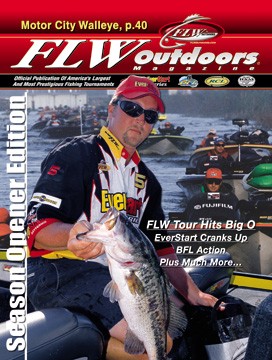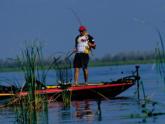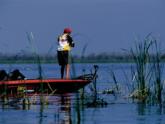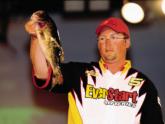Kenney’s karma

Wal-Mart FLW Tour, Lake Okeechobee, Jan. 23-26
When 350 anglers descended on Lake Okeechobee to practice for the 2002 Wal-Mart FLW Tour season opener, it looked as if a rewrite of the FLW Tour record books might be in order. Reports from anglers about Okeechobee’s bass fishing were almost frightening.
Comments like, “It is nothing to pull up and catch 20 pounds in 15 minutes,” or “The number of 20-pound limits is going to be phenomenal,” were common. Although there were reports of a couple of 10-pounders being caught, the big news was the prolific number of fish in the 5- to 7-pound class.
During the second half of January, South Florida’s weather went from sub-freezing to sub-tropical. Water temperatures warmed 20 degrees and brought big bass into Okeechobee’s “new” shoreline by the droves.
Bass were looking to make beds in a fresh crop of vegetation, which had recently been inundated with water. As they migrated into the new grass, the bass ate heartily, gobbling up anything that moved. But by the final day of practice Tuesday, Jan. 22, the big smiles on anglers’ faces turned to expressions of panic. Pros who went back to check areas they found three to four days before were shocked. The big fish were gone.
Anglers theorized that the sudden decline in catchable big bass hinged on the moon phase and intense fishing pressure. Many pros believed the big-bass feeding frenzy they had experienced before the tournament was the effect of a massive spawn resulting from the new moon. That spawn and South Florida’s warm weather brought out thousands of recreational anglers to catch the bass of a lifetime, adding to the fishing pressure.
By opening day’s weigh-in, it was obvious that the fabled 20-pound limits were not going to materialize. In fact, there was only one 20-pound-plus limit – 21 pounds, 11 ounces – weighed in by Rusty Rust of Hermitage, Tenn. By the end of the four-day tournament, there were only five limits that topped the 20-pound mark.
 What did materialize was a storyline involving two Wal-Mart FLW Tour rookies vying for the winner’s spotlight. The eventual winner, J.T. Kenney, Frostburg, Md., and runner-up, Jimmi Leuthner, Vernon, Vt., revealed that they had done their homework on the Big O. Many hours of studying Okeechobee’s fickle Florida bass gave these anglers some insight into the species’ peculiar spawning habits. Unbeknownst to each other, Kenney and Leuthner also discovered the same hot spot.
What did materialize was a storyline involving two Wal-Mart FLW Tour rookies vying for the winner’s spotlight. The eventual winner, J.T. Kenney, Frostburg, Md., and runner-up, Jimmi Leuthner, Vernon, Vt., revealed that they had done their homework on the Big O. Many hours of studying Okeechobee’s fickle Florida bass gave these anglers some insight into the species’ peculiar spawning habits. Unbeknownst to each other, Kenney and Leuthner also discovered the same hot spot.
Here’s how the tournament played out for the top 10 pros:
After spending two years as a co-angler and last season as a pro on the Wal-Mart FLW Tour, Anthony Gagliardi, Prosperity, S.C., proved he had learned a thing or two about fishing Lake Okeechobee.
 Like many anglers, Gagliardi discovered a fantastic Flapping Shad pattern during practice. He quickly reeled his Gambler bait over the grass to collect 13 pounds, 2 ounces on opening day.
Like many anglers, Gagliardi discovered a fantastic Flapping Shad pattern during practice. He quickly reeled his Gambler bait over the grass to collect 13 pounds, 2 ounces on opening day.
When the Flapping Shad technique failed on day two, Gagliardi adapted and began sight-fishing near Tin House Cove. This quick adjustment allowed him to slide into 20th place with 3 ounces to spare.
On days three and four Gagliardi sight-fished his way to a 10th-place finish in the Energizer boat. His two primary sight-fishing baits were white, soft jerkbaits rigged with 1/16-ounce sinkers on 20-pound test P-Line and green pumpkin Senkos rigged weightless on 15-pound test P-Line.
 Sam Newby, Pocola, Okla., weighed in the opening day Snickers big bass of 7 pounds, 15 ounces. The lunker anchored his two-day total of 27 pounds, 3 ounces, which qualified him for the top 20.
Sam Newby, Pocola, Okla., weighed in the opening day Snickers big bass of 7 pounds, 15 ounces. The lunker anchored his two-day total of 27 pounds, 3 ounces, which qualified him for the top 20.
Newby reported catching his fish near the Monkey Box and Harney Pond Canal. He was flipping a smoke red Rite Bite tube rigged with a 1/4-ounce weight on 20-pound test line. The key to his pattern, Newby says, was flipping isolated clumps of reeds.
Fishing from the Coleman boat on day four, Newby went to an area where he had caught some fish on day three, but to his disappointment, Leuthner and Kenney were already hard at work in the same area.
 Jim Tutt, Longview, Texas, accumulated his qualifying weight fishing in the Tin House Cove area of Okeechobee. Tutt targeted spawning fish relating to needle grass in 2 to 3 feet of water.
Jim Tutt, Longview, Texas, accumulated his qualifying weight fishing in the Tin House Cove area of Okeechobee. Tutt targeted spawning fish relating to needle grass in 2 to 3 feet of water.
He caught all of his keepers, 20 to 30 per day, on a Zoom fluke (watermelon seed) with the tail dyed chartreuse. He was using 15-pound test Triple Fish monofilament and Gamakatsu 4/0 EWG Superline hooks.
Tutt said the biggest key for him was fishing ultra-slow. “I was dead-sticking the fluke in holes in the needle grass,” he said. “I would cast well past the hole then slide the fluke into it and just hold it on slack line, waiting for a bite.”
On day four, Kellogg’s pro Jim Tutt returned to his primary areas on the north end of the lake. Despite catching 35 keepers, he only pulled together 7 pounds, 14 ounces to take eighth place.
Coming off a $100,000 second-place finish at the Forrest Wood Open last June, David Dudley, Manteo, N.C., started his 2002 Wal-Mart FLW Tour season with yet another top-10 performance. The Team Castrol pro rode the backside of a sight-fishing wave on Okeechobee, posting catches that dropped about a pound and a half per day.
Dudley caught all of his fish sight-fishing in the J & S Lock area. “I threw a Zoom Ol’ Monster rigged on a 1/4-ounce weight,” he reported. “I was fishing up shallow in the really clear water. In retrospect, I probably should have moved out towards the main lake a little more in the dingier water. I think there were probably bigger fish out there.”
If you have ever wondered what keeps pros going after dismal tournament days, just ask Keith Green from Arkadelphia, Ark. After day one, Green sat in a lowly 129th place with 6 pounds, 15 ounces. Then, with a complete change in areas and tactics on day two, he stepped into the limelight with a terrific catch weighing 21 pounds, 12 ounces that vaulted him into fifth place. For a moment, it looked as if Green might be the one to watch on days three and four.
 Green’s momentum shift on day two happened with a move to the North Shore. He abandoned his day-one area on the lake’s south end to check some offshore grass beds to the north. When he got there, he found a host of hungry post-spawn females with an appetite for a Rat-L-Trap (red crawfish with a chartreuse belly).
Green’s momentum shift on day two happened with a move to the North Shore. He abandoned his day-one area on the lake’s south end to check some offshore grass beds to the north. When he got there, he found a host of hungry post-spawn females with an appetite for a Rat-L-Trap (red crawfish with a chartreuse belly).
His glory hole began to dry up on day three when it produced only three fish, so he scrambled again, looking to a Flapping Shad (rainbow trout) to save him. The move paid off with five bass weighing 11 pounds, 12 ounces – enough for the top 10.
The Arkansas pro went to his Rat-L-Trap fish on day four looking for more magic, but this time it withered away. Green was left high and dry without a keeper at noon.
In a last-ditch effort, he ran 35 miles south to revisit the place he fished on opening day. Coming full circle paid off as Green boated 8 pounds, 8 ounces for sixth place in the Weed Eater boat.
Like Green, Joe Don Setina blasted from the back of the pack into the top 20 on day two with an impressive 17 pounds, 5 ounces. Unlike other top-10 competitors, who mostly fished north, Setina made the top 10 on day three by fishing in South Bay.
Before the tournament, Setina reported having his “worst practice ever.” While other competitors were catching fish everywhere, Setina struggle to catch even a limit in practice. But his limited success was based largely on a gamble that the waters of South Bay would clear during the tournament.
Having fished the Wal-Mart FLW Tour for four years, Setina learned that Okeechobee’s fish bite best in clear water. Although South Bay was not clear during practice, he noticed the area was clearing a little each day.
On day one, he stayed in South Bay and struggled to catch 7 pounds, 13 ounces. But on day two, his clear-water gamble paid off. “I must have caught 50 keepers,” Setina said. “I caught a 6-pounder and a 4-pounder and lost another big one.”
 By day three, the clearing waters of South Bay were on fire for Setina. He posted his biggest limit of the tournament – 19 pounds, 14 ounces. Helping the cause was a monster 9-pound, 3-ounce bass.
By day three, the clearing waters of South Bay were on fire for Setina. He posted his biggest limit of the tournament – 19 pounds, 14 ounces. Helping the cause was a monster 9-pound, 3-ounce bass.
Setina targeted isolated reed clumps and holes in the hydrilla and Kissimmee grass with a 4-inch Mizmo tube (green pumpkin) paired with a 1/4-ounce weight. He used 20-pound test P-Line spooled to a Shimano reel on a 7 1/2-foot flipping stick.
On day four, Setina’s red-hot area in South Bay cooled off, yielding only a couple of small keepers. This forced him to retreat farther inshore and catch sight fish from the Snickers boat to salvage a fifth-place finish.
 Breaking into the top five was one of bass fishing’s legends, Gary Klein from Weatherford, Texas. With the patience of a wading heron, Klein “dead-sticked” his way to into the top 10.
Breaking into the top five was one of bass fishing’s legends, Gary Klein from Weatherford, Texas. With the patience of a wading heron, Klein “dead-sticked” his way to into the top 10.
He fished the same water in the north end of Okeechobee four days, consistently posting better-than-average limits. His primary dead-sticking tool was a 6-inch Berkley Power Worm with a 1/8-ounce sinker tied to 17-pound Berkley Sensation line.
Though Klein could not visibly see the fish he was catching, he was certain they were spawning. He said he was catching about 30 keepers per day. “The whole key was letting the lure lie on the bottom with no action,” Klein said. “Several places I caught four or five keepers off of the same clump of vegetation.”
Jay Yelas, another well-known bass fishing baron, also cracked the top five at Okeechobee. The model of consistency, Yelas posted limits in the 13-pound range each day out.
Yelas keyed on the size of fry swimming in the area to determine where bass had or had not spawned. After finding mature fry over most of the lake’s south end, Yelas moved to the northeast corner of Okeechobee. There he found no fry and new beds.
 “The area I was fishing had clear water only a few hundred yards from the main lake,” Yelas said. “I think this was one of the last areas the fish used to spawn.”
“The area I was fishing had clear water only a few hundred yards from the main lake,” Yelas said. “I think this was one of the last areas the fish used to spawn.”
Yelas fished a Berkley Power Tube (watermelon) and a Berkley Power Lizard (black with a chartreuse tail) to tease visible bedding fish into biting. He also used Berkley Fire Line (30-pound test) to help get fish out of the thick vegetation.
Yelas relied heavily on his Lowrance X-15 GPS to mark the beds from day to day. “Okeechobee has miles and miles of grass beds and everything looks the same,” he said. “There is nothing to line up beds with, so marking beds on the GPS and being able to run right to them was invaluable.”
 At the final weigh-in, the season opener came down to a fish-by-fish shooting match between Wal-Mart FLW Tour rookies Leuthner and Kenney. At times jovial, Leuthner looked like he was about to spontaneously combust as he pulled lunker after lunker out of his bag.
At the final weigh-in, the season opener came down to a fish-by-fish shooting match between Wal-Mart FLW Tour rookies Leuthner and Kenney. At times jovial, Leuthner looked like he was about to spontaneously combust as he pulled lunker after lunker out of his bag.
Leuthner had certainly done his homework on Okeechobee. He had fished the lake before the tournament. By the time it began, Leuthner was very attuned to how the moon phases were affecting the fish.
Eventually, he could predict when females were going to over take a spawning area based on how the bucks were biting. Leuthner could not see the fish he was catching, he just knew from experience they were spawning in the dingy water.
During the first two days, Leuthner bounced back and forth between the lake’s south and north ends trying to keep tabs on seven different spots that he felt would host the next wave of big female bass.
On day three, while fishing a primary area to the north, Leuthner began to see the tell-tale signs of females moving in: very aggressive buck bass, multiple bites off of isolated reeds and big fish.
Once he determined that a fresh batch of females was moving in, Leuthner committed to the area. Ironically, he was not the only angler to find the new females. Kenney was nearby catching big fish, too.
Even more interesting was the unique way Leuthner was catching his fish. He used a spinning outfit. A 6-foot long Castaway heavy-action spinning rod teamed with a Daiwa SS 1300 reel spooled with 20-pound test Berkley Fireline was his weapon of choice from the Land O’Lakes boat.
Leuthner’s primary bait was a “no-name” (now officially called the No-Name) lure marketed by the JDC Lure Company. He rigged the No-Name, which looks like a Senko with two fingers on each end, wacky style with an Eagle Claw hook that features a wire clip to make it weedless.
Leuthner would cast the weightless bait into a bed and let it sink slowly to the bottom. He said his unique No-Name rig allowed him to fish behind other anglers and catch fish they missed.
Similar to Leuthner, Kenney was a Wal-Mart FLW Tour rookie who spent an ample amount of time on Okeechobee before the tournament. Kenney has made a habit of coming to Okeechobee from his home state of Maryland for a two- to three-month stint during the winter.
Kenney admits that he has guided for Roland Martin’s Marina, but he does not consider himself a full-time guide because he only works five or six days during his entire winter visit.
Kenney, however, does fish on a daily basis. Like Leuthner, he was very familiar with the peculiar spawning habits of Okeechobee’s bass in dirty water.
Within hours of takeoff, Kenney knew this tournament was not going to be a lunker fest as many had predicted, so he quickly adopted a drop-back-and-punt strategy, scrambling around to different areas just trying to scrape up enough fish to be in the top 20.
 On day two, he ran to the north end to gather a quick limit and again went searching for big fish. Kenney never found the big fish that day, but he gathered enough weight to make the cut.
On day two, he ran to the north end to gather a quick limit and again went searching for big fish. Kenney never found the big fish that day, but he gathered enough weight to make the cut.
Kenney might have to thank his co-angler on day three for a cue that big fish had started to move in. Kenney ran to the north intending to catch a quick limit. Within the first several casts, his co-angler hung a giant bass that he could not land. “I had not seen that quality of fish in there in several days,” Kenney commented. “So after getting my limit, I decided to poke around in the area just a little bit longer than usual. Just as I was about to pull the trolling motor up, I caught a 5-pounder. Then it clicked, I knew that the big fish were moving in. Suddenly my limit spot turned into a big fish factory.” Kenney checked in 21 pounds, 10 ounces on day three.
Kenney was fishing an area of Okeechobee that has a long history of being one of the best spots on the lake: an area on the north end where Harney Pond Canal meets Sportsman’s Cut.
He focused his fishing efforts on isolated clumps of reeds. His hardware consisted of a G Loomis 904 flipping stick, a Shimano Chronarch reel and 25-pound test flouroclear P-line.
 Kenney’s bait selection included a Gambler Crawdaddy (black-blue shadow) and a Gambler Flapping Shad (June bug). Kenney modified the bait by trimming the paddle-shaped tail down to a skinny diamond, which made it stand up straight in the bed. He flipped both baits with a 5/16-ounce screw-in weight.
Kenney’s bait selection included a Gambler Crawdaddy (black-blue shadow) and a Gambler Flapping Shad (June bug). Kenney modified the bait by trimming the paddle-shaped tail down to a skinny diamond, which made it stand up straight in the bed. He flipped both baits with a 5/16-ounce screw-in weight.
Carrying the banner for tournament sponsor EverStart Batteries, Kenney wore a tight poker face at the final weigh-in right up until he laid his last lunker bass into the basket and snatched the lead from Leuthner. Kenney’s final weight, 21 pounds, 13 ounces, was the heaviest limit of the entire tournament.
Lineberry’s loss lines up a win
After winning the 1999 co-angler points race in the Wal-Mart Bass Fishing League’s Piedmont Division, Greg Lineberry, Galax, Va., went on to win the 2000 co-angler points race in the EverStart Series’ Eastern Division. Now he’s leading the co-angler points race in the Wal-Mart FLW Tour thanks to a win on Lake Okeechobee.
 Lineberry used a Carolina-rigged lizard (green pumpkin) and a Team Daiwa jerkbait to bring in five bass weighing 10 pounds, 14 ounces on opening day while fishing the lake’s north end with David Cochran.
Lineberry used a Carolina-rigged lizard (green pumpkin) and a Team Daiwa jerkbait to bring in five bass weighing 10 pounds, 14 ounces on opening day while fishing the lake’s north end with David Cochran.
When Keith Williams of Conway, Ark., took him to the opposite end of the lake on day two, Lineberry did what all good co-anglers do: he adapted. With Williams, Lineberry fished a Gambler Flapping Shad to score five bass weighing 7 pounds, 9 ounces.
After two days, Lineberry rested in seventh place, which meant he was paired with eventual pro winner, J.T. Kenney, Frostburg, Md.
Ironically, in the semifinal round, it was a tremendous bass that Lineberry lost on his second cast of the morning that clued Kenney in on a wave of big females that were inundating the area.
“Originally Kenney’s plan was to go to the north end, get a limit and then run south for a big fish,” Lineberry said. “But the big one I lost, plus a 5-pounder he caught, convinced him to stay in that area for the day.”
In the end, Kenney’s decision to stay worked out well for Lineberry, too. Lineberry redeemed himself later that day by catching a 7-pound bass, which put him in the winner’s circle.